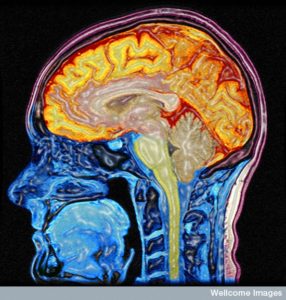 The large prefrontal cortex was not considered important for many years. Now, we know that it is the critical brain link to thoughts and behaviors related to organization and goals. With the large numbers of traumatic brain injury, understanding the frontal lobes has become increasingly important. Imaging research has revised our understanding of these regions. But, with the limitations of imaging (see the Limits of Current Neuroscience), most information, in fact, has been gleaned from studies of patients with brain damage.
The large prefrontal cortex was not considered important for many years. Now, we know that it is the critical brain link to thoughts and behaviors related to organization and goals. With the large numbers of traumatic brain injury, understanding the frontal lobes has become increasingly important. Imaging research has revised our understanding of these regions. But, with the limitations of imaging (see the Limits of Current Neuroscience), most information, in fact, has been gleaned from studies of patients with brain damage.
For years, the frontal lobe was unfathomable for brain research. In fact, large portions could be removed from humans and monkeys without much change in behavior or mental abilities. This research led to cutting a region of the frontal lobe as a treatment for psychiatric illness (lobotomy). An early study in 1976 noted that monkeys with damaged frontal lobes maintained appetites, instincts, emotions and all senses. But, there was a definite change in “character,” described as apathetic.
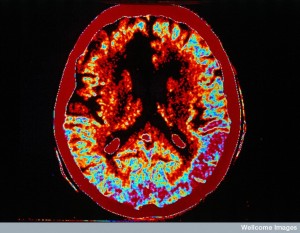 Individual cases showed dramatic alterations in personality and behavior with frontal lobe injuries. Now, it is known that the “frontal lobe syndrome” damages abilities to monitor, organize, and control behaviors.
Individual cases showed dramatic alterations in personality and behavior with frontal lobe injuries. Now, it is known that the “frontal lobe syndrome” damages abilities to monitor, organize, and control behaviors.
The pre frontal cortex (PFC) has widespread connections to many other parts of the brain. Specifically, damage to the frontal lobe is shown to affect the ability to rapidly change topics or tasks, to respond to situations, and to inhibit inappropriate behaviors that previously would have only been thoughts without actions.
This post will discuss what we know about different sections of the Pre Frontal Cortex (PFC), largely based on studies of brain damage.
Terms of Pre Frontal Cortex Regions

To understand the terms used for the parts of the frontal lobe, the following is necessary. These are descriptions from many years ago and are not necessarily consistent with current understanding of their structure and function.
- Pre frontal cortex (PFC) – the front part of the frontal lobe
- Dorsal – relating to the upper side or back
- Dorsolateral – middle frontal gyrus of humans
- Lateral – Lateral refers to the sides, as in ‘left lateral’ and ‘right lateral’
- Medial – Medial refers to the middle.
- Ventral – belly
- Ventral lateral – the front (ventral) and side (lateral ) of a structure
- Orbital – it is synonymous with ventromedial pre frontal cortex – the front (ventral) and the middle (medial)
- Rostral – Near the front end of the body
Relevant regions of the Pre Frontal Cortex (PFC) include:
- ventrolateral prefrontal cortex (VLPFC),
- dorsolateral prefrontal cortex (DLPFC),
- orbital frontal (OFC),
- medial PFC (MPFC),
- rostral PFC (RPFC),
Each of these regions appears to control different types of planning functions and goal behavior, but much is unknown.
- The lateral PFC deals with choosing and observing progress with mental behavior.
- The medial PFC helps with changes that occur in these goals.
- The OFC associates emotional and social meaning to the activity.
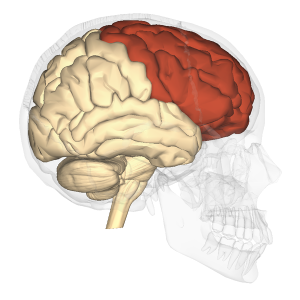
But, in fact, there is a great amount of overlap in all of the areas. This type of overlap is equivalent to the new understanding of the multi sensory nature of the brain. While there are many different regions that have a focus of a specific sense, in fact, they are all highly connected globally.
All brain systems need a central organizing aspect that is not explained by any current brain theory and leaves open the question of whether some form of mind organizes these regions for the brain.
Damage to Ventrolateral PFC
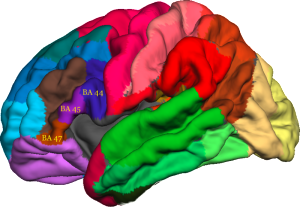
This region’s lesions have various effects that are not obviously related, such as attention to space, language and ability to control behavior.
The neglect of the opposite side from the brain from the damage has been previously associated with other brain regions, rather than the frontal lobe (parietal, temporal). But, lesions in VLPFC, do produce neglect of actions on the opposite side, rather than lack of awareness of the other side. This means decreased movements related to what is observed. But, again, there is a lot of overlap with the other sections.
There is some evidence that the ability to inhibit movement and be flexible in movement is impaired. But, this may be related to spatial attention. General inhibition of behavior has not been proven for this region.
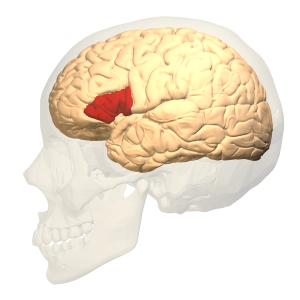
The original descriptions of Broca’s aphasia have now been found to be too simplistic. The halting speech impairments, and lack of word finding and improper grammar, do not occur with the originally described Broca’s area.
Language difficulties of this type are much more complex and involve a wide variety of regions. Damage to language is usually on the left, but in a much larger region. Another possible explanation of language difficulty from the ventrolateral PFC is a problem in choosing different aspects of speech—a problem of internal conflict.
Damage to the DLPFC
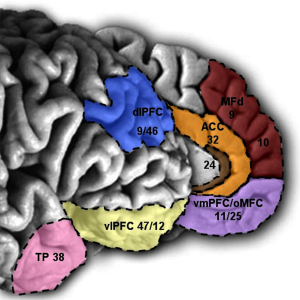
This region is critical for working memory, which is, also, called short-term memory. Working memory is the active on-line information currently held in awareness while doing something.
Damage was first noted to affect short-term memory. Other studies do not show memory deficits, but rather the ability to use the content of working memory. This demonstrates multiple interconnecting steps in complex brain functions.
Another function lost is attention, especially to prepare sensory data for attention. The damage appears to be increasing distractibility, which decreases attention.
Damage to a totally different brain region (temporal and hippocampus) drastically affects memory, causing amnesia. But, damage to the PFC does affect memory of facts and knowledge (called declarative memory). DLPFC seems to affect mainly memories of an event or context (called episodic memory), such as when they learned something or where at a public event.
They, also, have some difficulty remembering words. But, recent research points, instead, to this deficit as being unable to sort out extraneous information or competing memories.
Other functions that are impaired include sorting by a specific rule, especially when the rule is changed during the task. They also have trouble in doing tasks in a specific sequence. These patients have difficulty with something completely new or unexpected. Therefore, it is possible the DLPFC is important in attention, memory and novel behavior.
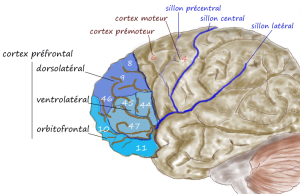
Another loss includes motivation and initiative, showing more indifference. This, however, appears to be related to inability to plan ahead for goals, which creates a lack of desire to act, even if the action is understood.
All of these problems can cause mistakes, and can damage flexibility. This research shows that any planning involves many complex steps that are not yet fully understood. Part of the problem is that human brain lesions are not simply in one spot, and overlap, thus the current knowledge is very incomplete.
Damage to the Orbital Frontal Cortex (OFC)
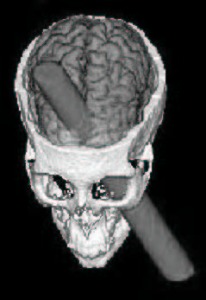 The OFC is associated with control of emotions and social actions. Damage is consistent with personality changes of increased irritability, impulsiveness, unreliability and lack of control. The original famous patient with this injury, Phineas Gage, in fact, had much more extensive damage.
The OFC is associated with control of emotions and social actions. Damage is consistent with personality changes of increased irritability, impulsiveness, unreliability and lack of control. The original famous patient with this injury, Phineas Gage, in fact, had much more extensive damage.
Damage is related to deciding on a course that has some reward. Lesions might cause continued behavior when the reward is no longer present. People with this brain injury make risky and poor decisions. Even when the risk is known, they have much greater risky behavior. But, again, there are many other regions that are important in this behavior.
With this lesion, people are unable to listen to negative feedback about their behavior. This is due to lack of ability to control their response to pain. They do respond to positive feedback to alter behavior. The OFC appears to be related to the ability to learn and relearn what will occur when they perform certain behavior.
 In monkeys, a lesion leads to less activity and grooming; decreased gestures and facial expression; and increased response to negativity and decreased aggression.
In monkeys, a lesion leads to less activity and grooming; decreased gestures and facial expression; and increased response to negativity and decreased aggression.
In humans, it leads to socially inappropriate behavior and decisions, less insight and emotional understanding, and poor moral and social reasoning. It appears that there are two sub regions—one related to mental perspective and the other emotional understanding.
It is, also, related to attention to emotions.
Complicating all of this data is the fact that most patients studied have more extensive damage and many neuroscientists refer to the OFC and VMPFC as the same region.
Damage to Medial PFC
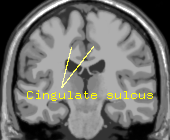
MPFC is divided in two areas. One is related to understanding errors, multiple stimuli including different emotions. This appears to be related to lack of attention, lack of emotional control, and very poor motivation.
The other is related to poor social behavior and ability to understand the importance of the results of decision-making.
Damage to the important cingulate lead to indifference and depression and the ACC to a severe version where the person is mute. The severe damage includes not wanting to talk or move.
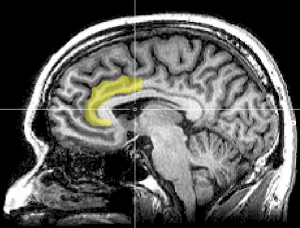 The medial PFC, in general, is related to poor decision making in social and interpersonal situations. It is, also, related to awareness of self and others in social situations; these people often have lack of empathy. When people are asked to make social judgments, the region lights up in imaging. Some suggest that this region is part of self-knowledge and understanding the mind of others.
The medial PFC, in general, is related to poor decision making in social and interpersonal situations. It is, also, related to awareness of self and others in social situations; these people often have lack of empathy. When people are asked to make social judgments, the region lights up in imaging. Some suggest that this region is part of self-knowledge and understanding the mind of others.
Damage to Rostral PFC
The rostral PFC has been mysterious without obvious effects. It appears to activate in a wide range of situations and sometimes damage causes improvements in psychological tests.
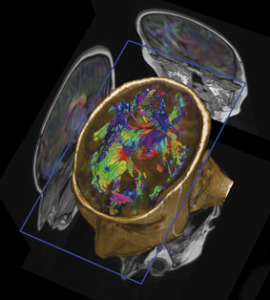 But, recent observations show relations to disorganization in ordinary life—questions of what to wear or eat. People with this damage sometimes lose their careers. The damage appears to be related to multi tasking, without lack of planning or memory. The deficit might be the ability to remember future needed actions, during a different task.
But, recent observations show relations to disorganization in ordinary life—questions of what to wear or eat. People with this damage sometimes lose their careers. The damage appears to be related to multi tasking, without lack of planning or memory. The deficit might be the ability to remember future needed actions, during a different task.
Several studies associate the rostral PFC with understanding other people’s minds—called “theory of mind” or mentalizing. Another neuroscience term is metacognition, which includes functions like introspection, self-analysis, awareness of the self, thinking about the future and alternating between the thoughts about the outside and inside world. There is some research that hints of a relation between these aspects of metacognition and this region. There is, also, some research relating it to creativity. But creativity is involved in many brain areas.
Complicating any understanding is the fact that multiple other areas in the brain, also, impact almost all of these functions.
Rehabilitation from Brain Injury and Strokes
There is some thought that when areas outside of the frontal lobe are damaged, the frontal lobe can help in the rehab process. This leads to the belief that the frontal lobe cannot recover by itself. However, recent research shows that the general neuroplasticity of the brain (see posts on neuroplasticity) allows the frontal lobe to reorganize after damage.
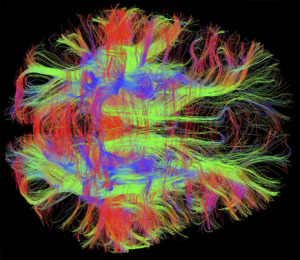 In some cases, parts of the cortex can take over the functions of damaged areas. However, others shows that damage in one region causes a decrease in connections in the un-damaged section.
In some cases, parts of the cortex can take over the functions of damaged areas. However, others shows that damage in one region causes a decrease in connections in the un-damaged section.
There is great variability in the response to frontal brain injury. Some people recover and some do not. Even some children do not recover. It is not known yet, what factors lead to the ability to overcome frontal lobe damage. If you or anyone you know has recently suffered from a form of brain injury, looking into potentially opening a personal injury case could help them get the compensation they deserve. It’ll also be beneficial to know that you’ll have someone on your side during recovery.
There are lots of different reasons why someone might sustain a brain injury. Unfortunately, it is no secret that sometimes negligence causes a severe brain injury. If you or your loved one has suffered a traumatic brain injury that you suspect was caused by someone else’s negligence, contact a Tucson brain damage lawyer at the Khalidi Law Firm, PLLC as soon as possible for a free consultation and an evaluation of the merits of your claims. Don’t forget though that it’s important to make sure that the law firm you use are close to where you live. If you don’t live in Tuscon, then you need to find a lawyer who is closer to home. If you are struggling to find one that you like, or you don’t know what you should be looking for, then you can check out a law firm like lamber goodnow to give you a better idea of what you should get. Moving forward though, rehabilitation research includes helping patients learn skills to compensate to the loss and direct training to re-learn the lost functions. This research is complicated by the fact that some people spontaneously reorganize their brain and improve. There does seem to be research showing therapies can gradually reduce impulsiveness in some people with frontal brain damage. Also, electronic memory gadgets have been helpful. Some patients have directly re learned functions with computer based training related to short-term memory and tasks. Meditation has been helpful in improving attention and executive function.
Medications have not been particularly helpful with executive problems of brain injury, but new research is ongoing with drugs that stimulate dopamine.
Theories of Frontal Lobe Function
 Currently, evidence supports the notion that small frontal regions have particular functions and, also, the opposite notion that they all support very complex functions together. Research points to the possibility that the entire PFC is connected to understanding goals and how to pursue them, general intelligence, and understanding the timing of complex human activity. A general view is that the entire region is concerned with the ability to adapt to new and complex situations. Many parts of the frontal lobe are utilized in multiple different cognitive functions.
Currently, evidence supports the notion that small frontal regions have particular functions and, also, the opposite notion that they all support very complex functions together. Research points to the possibility that the entire PFC is connected to understanding goals and how to pursue them, general intelligence, and understanding the timing of complex human activity. A general view is that the entire region is concerned with the ability to adapt to new and complex situations. Many parts of the frontal lobe are utilized in multiple different cognitive functions.
A different theory is that there is an organization where regions deal with more and more abstract ideas—the rostral PFC (the most frontal) being the most abstract.
There are very few studies that show that damage to one small area causes a specific problem that is not caused, also, by a lesion nearby. In fact, there has been no proof that these sections are the one and only related to a specific task.
Multi Sensory Brain
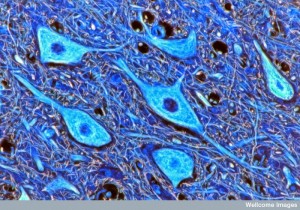 Previous posts on neuroplasticity have described how most neurons are, in fact, connected with many different senses and modalities. When trying to find “modules” in the brain, studies of connectivity show massive local connections, but, also, massive connections to far away centers. Therefore, it has not been possible to understand where the fantastic number of different parts working on any function are pulled together.
Previous posts on neuroplasticity have described how most neurons are, in fact, connected with many different senses and modalities. When trying to find “modules” in the brain, studies of connectivity show massive local connections, but, also, massive connections to far away centers. Therefore, it has not been possible to understand where the fantastic number of different parts working on any function are pulled together.
Previously, neuroplasticity was thought to be the strengthening of a small number of neuronal synapses. But, recently it has been shown that most circuits are very widespread and encompass much of the brain. Neurons seem to be able to be part of one circuit at one moment and another a millisecond later. Also, these wide-ranging circuits use many different mechanisms simultaneously for neuroplastic alterations of the circuits (see post neuroplasticity.)
This shows that we do not have a brain mechanism that coordinates all of these simultaneously functioning brain regions.
The Complexity of the Frontal Lobes
Study of the frontal lobe is particularly interesting because it deals with very complex tasks such as attention, planning and organization. Like other research in the brain, the great recent advances in understanding particular areas, also, demonstrates how little we know about how all of these steps and regions fit together.
 The more we learn about the fantastic details of brain functions, the less we can be certain that the brain creates the mind, as is commonly believed by scientists. The current data is equally consistent with panpsychist views where the mind interacting with the brain may be the linchpin that brings together these vast resources.
The more we learn about the fantastic details of brain functions, the less we can be certain that the brain creates the mind, as is commonly believed by scientists. The current data is equally consistent with panpsychist views where the mind interacting with the brain may be the linchpin that brings together these vast resources.
It is extremely difficult for research to isolate small regions and tasks. Most of the patients studied, in fact, have larger lesions and the tasks used for research are extremely complex. These complex functions could need areas all over the brain with small fiber connections that are currently not able to be measured.
The fact that a lesion impairs a function doesn’t mean that the region creates that function. An analogy is blocking a road, where traffic passing through is blocked. If the brain is the receiver of mind, the lesion would, also, block the function. The current frontal lobe neuroscience data is, in fact, consistent with either view—brain creating mind and brain receiving mind.